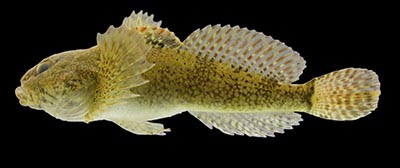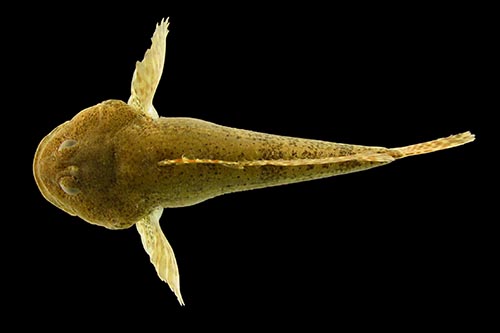 Fisheries Blog
Fisheries Blog
Although many of us know about the common game species, the non-game species are less well known — not surprising since it is tough to observe fish in their natural habitats. Illinois has over 200 fish species occupying a wide variety of waters, ranging from large rivers to small streams, and from small ponds to Lake Michigan. Our non-game species blog is highlighting those lesser-known Illinois species. We hope you enjoy the pictures and the information on their life histories, distribution, family ties, and other interesting facts about this fascinating group of animals.
Mottled Sculpin
What’s in a name? The scientific name of Mottled Sculpin is Cottus bairdii. Cottus is the name of a large (many) headed Greek Mythological creature — appropriate since Sculpins have very large heads in relation to their body size. Cottus is also an old Greek name for a Miller’s thumb. bairdii is in honor of Spencer F. Baird, a famous fish biologist and the first U.S. Fish Commissioner.
The sculpin family, Cottidae, includes at least 275 species worldwide. Most of these live in northern oceans, including the Pacific, Atlantic, and Arctic. However, some species are restricted to freshwater; for example, the genus Cottus , which has members across northern North America, Europe, and Asia. The genus Myoxocephalus is primarily marine, but does include some freshwater representatives, one of which lives in the Great Lakes.
 As mentioned, Mottled Sculpins have a large head. The body tapers sharply toward the tail, which gives them a triangular shape, similar to a tadpole. Unlike most fishes, their eyes sit forward on their head. As the common name suggested they have a mottled, brown coloration, often with dark bands, which serve to camouflage them against rocky substrates — their favorite habitat. They have a reduced swim bladder and large pectoral fins which suits them well for their bottom dwelling habit and helps keeps them in place against flowing water. They do not have scales, but do have tiny bumps which give them a prickly, sand paper texture. Rarely do they exceed five inches in length.
As mentioned, Mottled Sculpins have a large head. The body tapers sharply toward the tail, which gives them a triangular shape, similar to a tadpole. Unlike most fishes, their eyes sit forward on their head. As the common name suggested they have a mottled, brown coloration, often with dark bands, which serve to camouflage them against rocky substrates — their favorite habitat. They have a reduced swim bladder and large pectoral fins which suits them well for their bottom dwelling habit and helps keeps them in place against flowing water. They do not have scales, but do have tiny bumps which give them a prickly, sand paper texture. Rarely do they exceed five inches in length.
Mottled Sculpins live almost exclusively along the bottom. They are found primarily in streams with cooler temperatures, mostly in the riffle areas. They also occur along the near shore areas of Lake Michigan. They are not fast swimmers, but instead ambush their prey consisting of aquatic insect larvae, small crustaceans, and sometimes small fish. They spawn in April, using an elaborate mating behavior like many Sculpin species. The male cleans and guards the eggs, typically around 200, attached to the bottom of a rock. Their life span is about four or five years.
Due to their preference for cooler water temperatures, their distribution is very limited. They are relatively common in some tributary streams of the Fox River, but very sporadic elsewhere in Illinois. They also occur along the shores of Lake Michigan, which are also cooler waters. However, they are becoming hard to find, likely due to the invasion of the non-native fish species, Round Goby, which has similar habits. They are relatively stable in the Fox Basin, but are vulnerable to urban development, and any changes in ground water flow. Global warming is also a threat to this cool water species.
Illinois fish distribution maps can be found at: https://www.inhs.illinois.edu/collections/fish/data/ichthyology/ilfish/
Photo Credit: Dr. Philip Willink



